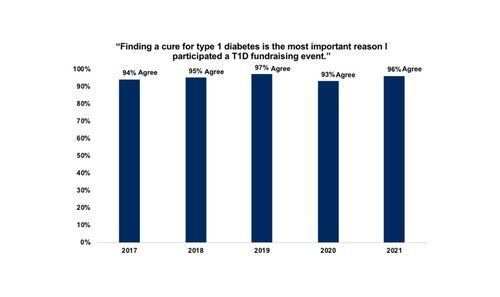
Every year, T1D nonprofits raise hundreds of millions of dollars at special events like walks, golf outings, bike rides, and galas. This money is the life-blood of the T1D research ecosystem because it is raised directly from people most impacted by the disease: those living with T1D and their loved ones. Without their generosity, much of the research that gives us all hope for a better future would be impossible.
The JDCA conducts regular surveys of T1D event participants to understand what motivates them to give. Why do people participate in fundraising events for T1D nonprofits like JDRF and the ADA? How do they expect their money is used? The survey was distributed in September 2021 to a representative sample of people who participated, either in-person or virtually, in JDRF or ADA events over the past year.
Despite a major shift from in-person to virtual fundraising events since the start of the COVID-19 pandemic, the essential finding of this year’s survey is the same as years before: people donate to and participate in T1D fundraising events because they want to fund cure research. Further, results indicate the ongoing cuts to research spending at JDRF and the ADA may pose a threat to the T1D community’s sustained support.
The key findings are summarized in the picture.
Key Findings
- The top priority of people who participate in T1D fundraising events is supporting cure research.
- 96% claim finding a cure is the main reason for their event participation.
- 89% claim cure research funding is “extremely important” to them.
- More people are participating in fundraising events compared to 2020, but still low compared to pre-COVID years.
- 40% of respondents participated in a fundraising event during 2021.
- 26% of respondents participated in a fundraising event during 2020.
- COVID-19 rendered participation in fundraising events a virtual activity.
- 61% of participation was virtual
- 20% of participation was in-person
- 19% of participants attended both types of events
- Donors believe money raised at fundraising events should directly support cure research.
- 96% believe the majority of money raised at events should be used for cure research
- 79% believe 100% of money raised at T1D fundraising events should be used for T1D cure research
- Donors are less likely to support JDRF and the ADA when they learn how much of their donation is actually allocated to T1D research: $0.33 of every dollar at JDRF and $0.02 of every dollar at the ADA.
- 7/10 claim they are less likely to donate to JDRF in the future.
- 8/10 claim they are less likely to donate to the ADA in the future.
- Donors want their voices heard in research funding decisions.
- 96% believe nonprofits should seek direct donor input when making research funding decisions.
- The T1D community does not feel represented by their regional JDRF and ADA chapters.
- 55% of respondents do not feel their values are accurately represented by their local T1D organizational chapter.
Conclusion
It is difficult to replicate the sense of community fostered at an in-person fundraising event on an online platform. However, surveys show that what connects the participants in these events - even more than their desire for in-person community - is their desire to fund T1D cure research.
While COVID-19 has undoubtedly had an adverse effect on grassroots fundraising, the decrease in donor involvement at JDRF and the ADA cannot be solely attributed to the pandemic. As long as JDRF and the ADA dedicate only small portions of what they raise at events to T1D cure research, they will be misaligned with their own donors and therefore at risk. In order to ensure long-term viability, these organizations should focus their efforts on funding cure research and repairing the misalignment of donor interest and organizational spending.
